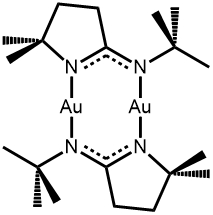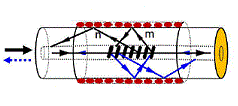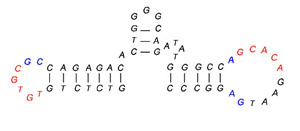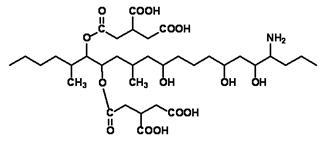Research
Chemistry graduate and undergraduate students are extensively engaged in research with faculty members at the university and adjunct professors and other researchers outside of Carleton. Research is underway in many exciting areas in chemistry, notably cutting-edge work in analytical chemistry, nanotechnology, polymer science, environmental chemistry and toxicology, to name a few.
Graduate students benefit from our membership in the Ottawa Carleton Chemistry Institute (OCCI) which is a joint graduate program with the University of Ottawa.
Undergraduate research is an important component of our programs. Our students work closely with faculty members and their laboratory groups on research projects. There are many ways for undergraduate students to get involved, including paid positions, volunteer work, summer research positions, and credit in our fourth year honours research project course.
We invite you to look at faculty research interests and find ways in which you can become a member of a cutting edge research team.
-
The Avis Lab studies both fundamental and applied aspects of food and plant microbiology. More specifically, we are interested in microbial food spoilage and plant pathology. Our main focus is the use of alternatives to synthetic chemicals to control the growth of microorganisms on food crops and to reduce food spoilage.
We are investigating the use of beneficial microorganisms (biological control agents) as well as microbial and plant extracts and purified natural antimicrobial compounds as potential alternatives to control harmful microorganisms. These novel control measures are meant to mitigate problems associated with some synthetic control measures such as risks to health and the environment as well as to delay or eliminate the onset of resistance development in the targeted microorganisms.
Our laboratory uses a multidisciplinary approach including basic microbiology, biochemistry, bio-analytical and bio-physical chemistry, membrane and lipid chemistry as well as molecular biology, genetics, and genomics.
-
Our group is mainly interested in the development of precursors and processes for atomic layer deposition (ALD), and we were the first academic research group in Canada to work in this field. As synthetic chemists, we try to determine the mechanism of the surface chemistry and thermal decomposition routes to better design precursors and tune our processes. We look at many different processes and target films, but some themes can broadly be drawn through our work.
Ligand and Precursor Design
We have been interested in group 11 metals for several years, and have contributed to precursor and process design for copper and gold metal ALD solutions.We employ guanidinates, iminopyrrolidinates, and silylamides as anionic ligands for copper metal precursors, occasionally employing carbenes as a neutral coordination ligand to complete the coordination environment for Cu(I). The best example of a precursor is a hexamethyldisilazido N-heterocycliccarbene copper(I) that deposits using a thermal process on a noble metal or with plasma hydrogen on silicon and glass.
We have also reported the first ALD deposition of gold metal using plasma oxygen and water. This process uses a trimethyl trimethylphosphine gold(III) precursor that is a liquid at room temperature and exhibits a surprising stability to oxygen and water.

Optical Fibres as Substrates
With collaborators in the electronics department at Carleton, we have done a significant amount of work on depositing metal and non-metal films on optical fibres with Bragg gratings printed in their core. These “tilted fibre Bragg gratings” (TFBGs) can be used to sense the index of refraction around the fibre due to light propagating to the fibre’s cladding/air interface. With gold metal, we have shown that TFBGs are the most sensitive to refractive index changes and suspect that ALD of gold on fibres will drastically improve their performance.

Group 13 Precursors
We have been interested in group 13 chemistry from our first group publication, and have published several mechanistic thermal studies and process development papers. We remain interested in gallium precursors like this diethyl amidinato gallium(III) compound because of the difficulty in tuning these precursors to thermal deposition of nitrides.
We have found that the trisguanidinato compounds are easy-to-make precursors with a lot of promise, and continue to look at precursors like this trisguanidinato indium(III) compound that undergoes chemical vapour deposition at moderate temperatures with water to for thin indium oxide films.
-
Our group seeks to develop biosensors and ‘smart’ materials based on DNA aptamers. Projects in our lab draw on inorganic, organic, materials, and nucleic acids chemistry. Several main research themes are outlined below.
Aptamer Based Polyelectrolyte Thin Films for “Smart” Materials
Our research explores strategies for the controlled release of a molecular target through nanoscale aptamer-polyelectrolyte multilayer films and microcapsules. We are investigating innovative approaches to trigger the release of a model compound by exploiting the binding affinity and selectivity of aptamers, as well as their ability to change shape upon target binding

Biosensors

Novel chemically-modified oligonucleotides are being examined for use in electrochemical and optical biosensors. Substrates such as gold and glassy carbon electrodes, as well as gold-coated tilted fiber bragg gratings (in collaboration with Dr. Jacques Albert: DOE, Carleton University) are being investigated.
In vivo Aptamer Applications
Results from our development of a dopamine aptamer have launched a collaboration with Dr. Matthew Holahan (Neuroscience, Carleton University) where we are exploring its effects in the brains of animal models. Our recent PLoS ONE paper describes our exciting results and is the first study reporting on the effects of an aptamer in the brain.

New Aptamers

New aptamers for important targets are also being developed. Targets include neurotransmitters, viruses, disease biomarkers, and toxins.
-
Functional foods and nutraceuticals
Antioxidants, anti-inflammatory and anti-stress of bioactives in foods and human health, environmentally friendly extraction techniques
Projects are:
Antioxidant and anti-inflammatory activity of wheat, rye and triticale bran
Antioxidant activity in food and cell membrane
Anti-inflammatory activity using cell culture containing inflammation lines
Prebiotic/Probiotic activity of cereals, oilseeds and berries in dairy products, mainly yoghurt
- Anti-stress properties of melatonin in sour cherries using cell culture and animal models
- Environmentally extraction methods
- Microwave technology
- Supercritical CO2 extraction
-
Novel Plasmonic Nanomaterials: Design, Properties, and Application
In this research project we:
- synthesize metal nanocrystals of various nature.
- assemble them in two and three dimensional plasmonic structures.
- fine tune their optical properties (refractive index sensitivity, Raman and fluorescence signal enhancement).
- apply in fiber based sensor devices, solar cells, and for imaging.
Antimicrobial Peptides: Molecular Mechanisms of Action
In this project we investigate new potent antimicrobial peptides in order to determine the effect of small modifications in the primary structure on their physicochemical properties and antimicrobial activity with the objective of creating safer and more efficient antibacterial agents.
-
Research Area: Analytical and bioanalytical chemistry
Specific Topics:
Instrumental analysis of biochemical and environmental samples for public health using capillary electrophoresis, dynamic light scattering, fluorescence spectroscopy, gel permeation chromatography, liquid chromatography, mass spectrometry and 3D microfluidics. New photochemical, electrochemical and optical phenomena are developed into analytical methods for enhanced sensitivity and selectivity: (a) molecularly imprinted polymers for the selective determination of therapeutic drugs in serum, ochratoxin A in red wine, and estrogenic compounds in wastewater treatment by solid-phase extraction with differential pulsed elution; (b) self-assembled monolayers and electropolymerized thin films for adsorption of toxic metals (Hg2+) and mycotoxins; (c) functionalization of colloidal nanoparticles for removal of endocrine disrupting compounds in environmental water and radioactive nuclides (Pu-238, Sr-90, Y-90,) in urine; (d) detection of nanoparticles in environmental water and air samples; (e) DNA binding with inorganic oxide nanomaterial surfaces; (f) interaction of nanoparticles with graphene quantum dots and simulated lung fluid; (g) surface chemistry/biochemistry of nanoparticles as related to electrochemical analysis by cyclic voltammetry and electrochemical impedance spectroscopy.
-
Our group is broadly focused on synthetic organic chemistry, particularly with a direct eye to applications in the biochemistry world and engineering. Our approach to research is highly collaborative with other academic researchers and corporate partners.
We have recently developed innovative applications of diazomethane to enhancing the analysis of certain biological molecules, particularly certain lipids and peptides, via mass spectrometry through the introduction of fixed, permanent positive charge(s). This work has been dubbed TrEnDi (Trimethylation Enhancement using Diazomethane) and is done in conjunction with our colleague Prof. Jeff Smith (Carleton University, Department of Chemistry). Extension and expansion of this work is ongoing, with current directions focused on the development of new derivatization reagents, expansion of the scope of substrates suitable for derivatization, and facilitating new fragmentation pathways in tandem mass spectrometry that will facilitate structure identification.
Our group is also currently engaged in a collaboration with Prof. Ron Miller (Carleton University, Department of Mechanical and Aerospace Engineering) to understand the chemical fate of antioxidants in lubricating oils. This work involves the synthesis of various compounds proposed to be the oxidized antioxidants. This work is aimed at improving the understanding of how lubricants are oxidized and their functional lifetimes.
Our group’s expertise and previous work encompasses the total synthesis of natural products, including lipids, polyketides and terpenes; as well as methodologies, including metal-catalyzed organic processes.
-
My research interests involve studying chemical interactions between microorganisms and their environment through the biosynthesis of natural products. Natural products are ecologically significant as they enable specific species/strains to compete for resources or occupy an ecological niche. While natural products are important socioeconomically, for example as pharmaceuticals, often unwanted chronic exposures have adverse human health effects. These effects are often poorly characterized. To facilitate toxicological experiments and exposure assessments for better hazard characterization, chemical standards are required. This involves evaluating the toxigenic potential of ecologically relevant species/strains, purifying the principle toxins and elucidating their chemical structures. This type of research can have important implications for evidence based decision making, toxicology and chemical ecology.
Students in the group develop transferable skills by (1) growing organisms to bio-synthesize natural products, (2) purifying and structurally characterizing chemicals, (3) developing analytical methods for chemicals/toxins in complex matrices, and (4) assessing the biological activity of purified compounds. We currently focus on natural products produced by cyanobacteria in freshwater and fungi that contaminate crops.
-
The motivating scientific interest of my research is the role of fungal metabolites in determining population structure. I became interested in this during my postdoctoral work where I observed that distributions of marine fungi on wood seemed to be partially determined by the production by some species of anti-fungal metabolites.
Few academic research programs in North America work in the area of natural pro ducts from fungi and the program produces highly qualified personnel that will be able to seek careers in the pharmaceutical and environmental industries. This effort reflects also the Canadian Government priority to engage more scientists outside medical schools in the problems of medical research.
There are three lines of research conducted in the Miller laboratory. Thefirst area of research is into the link between damp housing and health. The second area is the role of endophyticfungi in conifer needles. Thirdly we conduct research on toxinsin food.
-
My research seeks to understand the molecular mechanisms associated with exposure to emerging environmental contaminants. Specifically, I am interested in how these contaminants interact with dietary lipids (e.g. omega-6 fatty acids) and their interference with lipid metabolic signaling pathways, which control many significant biological processes. By using tools from biochemistry, analytical chemistry, environmental toxicology, and molecular biology, my research program investigates how total environment (nutrition and emerging contaminants) affects an organism’s cell function, injury, and protection. Examining the interplay between lipids and contaminants will enhance understanding of how our total environment contributes to the regulation of health and onset of disease.
-
Overview
Mass spectrometry (MS) has proven to be a powerful analytical tool in many scientific fields for nearly a century. Advances made in soft ionization techniques such as electrospray ionization (ESI) and matrix-assisted laser desorption ionization (MALDI) have expanded the use of MS to the biological sciences, allowing biomolecules to be ionized and sampled in the gas phase without fragmentation. These advances have been echoed in an explosion of publications over the past 20 years that have used MS as a tool to illuminate information pertaining to a biological question. The majority of MS-based bioanalytical studies to date have focused on cataloguing the species present in a sample at a static moment in time. Although this is important, measuring the dynamics of a system in response to a stimulus not only aids identification efforts, but offers mechanistic insight into the cellular processes involved. Gaining a better understanding of these dynamics, often expressed through a change in concentration or in the degree of modification, will enhance the accuracy of cellular models, assign functional roles to the identified species as well as highlight new diagnostic and therapeutic strategies. The research program of the Smith group will focus on developing novel methods to efficiently measure biomolecular dynamics in living systems with the downstream goals of elucidating disease biomarkers and further characterizing biosynthetic and biochemical pathways.
Instrumentation
The Smith lab uses mass spectrometry as a tool to probe the dynamics of various biomolecules. At present, we mainly conduct research in the area of protein analysis (“proteomics”) and lipid analysis (“lipidomics”). The laboratory is equipped with high-resolution hybrid quadrupole time of flight, triple quadrupole and linear ion trap mass spectrometers. All of these instruments achieve ionization via electrospray ionization and are coupled to high performance liquid chromatographs. The lab additionally houses two gas chromatography-MS systems, one equipped with a headspace sampler.
TrEnDi
Trimethylation Enhancement using Diazomethane (TrEnDi) is a published technique developed by Professors Jeffrey Smith and Jeffrey Manthorpe at Carleton University. The method increases the sensitivity of mass spectrometric detection by assigning a fixed, permanent positive charge to amino groups. It allows for increased and predictable sequence coverage for peptides in proteomic analyses, and increased limits of detection for several important lipid classes in lipidomic analyses.

Wasslen, K.V., Canez, C.R., Lee, H., Manthorpe, J.M., Smith, J.C. (2014) Trimethylation Enhancement using Diazomethane (TrEnDi) II: Rapid In-Solution Concomitant Quaternization of Glycerophospholipid Amino Groups and Methylation of Phosphate Groups via Reaction with Diazomethane Significantly Enhances Sensitivity in Mass Spectrometry Analyses via a Fixed, Permanent Positive Charge. Analytical Chemistry. Oct 7;86(19): 9523-9532. DOI: 10.1021/ac501588y. PMID: 25208053. Quantitative Proteomics
The Smith lab uses microfluidic devices to manipulate biological samples in a highly efficient manner to elucidate protein dynamics and post-translational modification patterns using MS in conjunction with TrEnDi. Through studying the dynamics of protein abundances or the modes in which they are modified in cells that are stimulated in some manner (or that are either diseased or healthy), our research will help define how cells communicate with each other, their environment and themselves.
Quantitative Lipidomics
Although lipids have been studied for decades and have been largely regarded as energy storage or structural molecules, recent progress in lipid research has revealed many novel and important roles for lipids in cellular signaling. Many classes of lipids are easily analyzed by mass spectrometry; however, some are more difficult to observe. The Smith laboratory will focus on developing novel methods to identify lipid species in the context of complicated biological samples. To date, the development of TrEnDi has achieved this goal by increasing the sensitivity of some lipid classes over an order of magnitude. Ultimately, we will apply the novel methods that are developed to investigate lipid dynamics in biological systems to aid our understanding of the roles they play in cellular life.
-
The Storey Lab investigates the basic biochemical principles of how organisms endure and flourish under extreme conditions. Our research seeks out the molecular mechanisms that underlie unique animal adaptations through the study of enzyme properties, gene expression, protein posttranslational modifications, and signal transduction mechanisms. The Lab is particularly well-known in the field of cryobiology for its studies of animals that survive whole body freezing during the winter, especially the frozen wood frog “frog-sicles” that have made Ken Storey’s work popular with many TV shows and magazines. But that’s not all. Our research is linked by 2 main themes: (1) biochemical adaptations that aid survival of environmental stress, and (2) metabolic rate depression – the ability to suppress metabolism and transition into a torpid or dormant state when times are tough. We use a range of modern molecular tools to explore these themes including enzyme kinetic analysis, protein purification, PCR, immunoblotting, differential scanning fluorimetry, Luminex technology and bioinformatics.
-
Research interests
- Bioactive compounds in Human milk: role in reduction of lung and instetinal diseases in newborns
- Extraction, enzymatic hydrolysis, LC-MS/MS, Structure-function of food peptides
- Protective role of peptides agianst oxidative damage in different cell culture models
- Immune modulation properties of peptides
- Strategies to reduce oxidation of parenteral and multivitamins solutions
- Phytosterols: Synthesis of derivatives to improve human heart health
-
Our group is mainly involved in fundamental research in organic optoelectronic materials and devices, which is driven by almost infinite spectrum of functional possibilities and freedom in molecular designs and syntheses. We are particularly interested in three distinct properties, namely chromogenic, photovoltaic and chiroptical properties, of organic near-infrared (NIR) materials having the low-bandgap p-conjugated donor-acceptor chromophore and redox-active meta complexes. For the NIR chromogenic properties, we explore and study the tunable photo-/electroluminescence, electrochromism, photochromism, thermochromism, and piezochromism. The photovoltaic property is targeted specifically within the spectral range of 800-1600 nm, for potential bio-imaging, security ad telecom applications
-
My research examines alteration of protein structure and function by oxygen, in particular, the lack of such alteration under low oxygen (or hypoxic) conditions. Such conditions are commonly encountered by humans at high altitudes, during development, and in clinical conditions such as sleep apnea, hypertension, ischemic (or the cutting off of blood flow) heart disease, acute myocardial infarction, cardiac arrest, cerebrovascular disease (such as stroke), and neurocognitive deficits. Systemic or localized hypoxia affects metabolic pathways, induces angiogenesis (or the formation of new blood vessels), and affects inflammatory responses. Many of the factors that are involved in hypoxia survival are also found to be upregulated in most human tumors. As well as disease, ischemia-associated hypoxia plays a role in tissue damage during organ transplantation as well as preservation. Using mammalian cell lines (human, monkey, rat, etc.) as the model system and a proteomic approach, we examine changes in protein expression, function and stability under varying oxygen conditions.